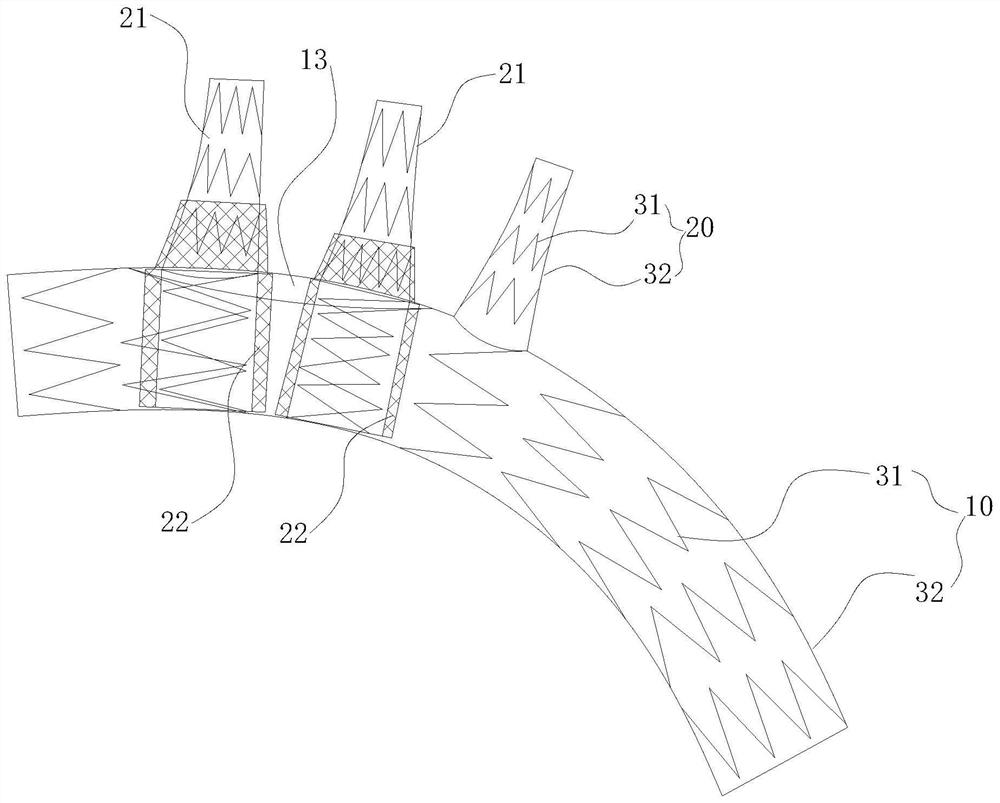Combined intravascular stent with branch and implantation method thereof
A vascular stent and combined technology, applied in the field of medical devices, can solve the problems of large individual differences in spacing, high risk of displacement and occlusion, and unsatisfactory fitting of branch stents, and achieve the effect of reducing specifications and improving flexibility.
- Summary
- Abstract
- Description
- Claims
- Application Information
AI Technical Summary
Problems solved by technology
Method used
Image
Examples
Embodiment 1
[0044] Such as Figure 1 to Figure 5 As shown, the combined vascular stent with branches includes a main body 10 and a branch body 20. The main body 10 has a first tube end 11 (proximal end), a second tube end 12 (far-center end), and a second tube end 12 (distal end). There is a lumen between the first pipe end 11 and the second pipe end 12, and an elastic branch port is provided on the pipe wall of the main pipe body 10; the branch pipe body 20 includes a branch pipe part 21 and a branch seat body 22, divided into The support body 22 is connected to the main body 10 , and the branch pipe part 21 communicates with the lumen of the main body 10 through the branch port of the main body 10 . The outer diameter size range of the main body 10 is 20mm-40mm (such as: 20mm, 22mm, 24mm, 26mm, 28mm, 30mm, 32mm, 34mm, 36mm, 38mm, 40mm); the outer diameter size range of the branch pipe body 20 is 8mm -14mm (eg: 8mm, 10mm, 12mm, 14mm).
[0045] The implantation method of the combined va...
Embodiment 2
[0059] In this embodiment, there are three branch tube bodies 20, and the three branch tube bodies 20 all adopt an independent split structure, that is, they all include a branch tube part 21 and a branch seat body 22. The body 10 is implanted into the blood vessels of the human body, and the opening area 13 is aligned with the three branch vessels on the human aortic arch, and then the three branch tube bodies 20 are implanted into the branch blood vessels sequentially starting from the left subclavian artery. status as Figure 7 shown.
Embodiment 3
[0061] Such as Figure 8 , Figure 9 , Figure 10 As shown, in this embodiment, two fixed branch pipe bodies 20 are arranged on the main pipe body 10, and an independent branch pipe body 20 is matched. The structure of the independent branch pipe body 20 is the same as that of Embodiment 1, The second embodiment is different. In this embodiment, the branch base 22 adopts an umbrella disc structure, and the opening area 13 is set as a mesh structure, which can be made of metal material or polymer material.
[0062] In this embodiment, the branch stent selects different assembly release methods according to different introduction paths, taking the left common carotid artery as an example:
[0063] a. Retrograde introduction of the left common carotid artery, release the proximal umbrella disc of the branch stent first, lift the delivery sheath until the umbrella disc and the top surface of the stent arch of the main body 10 are well fitted, and then release the stent of the br...
PUM
 Login to View More
Login to View More Abstract
Description
Claims
Application Information
 Login to View More
Login to View More - R&D Engineer
- R&D Manager
- IP Professional
- Industry Leading Data Capabilities
- Powerful AI technology
- Patent DNA Extraction
Browse by: Latest US Patents, China's latest patents, Technical Efficacy Thesaurus, Application Domain, Technology Topic, Popular Technical Reports.
© 2024 PatSnap. All rights reserved.Legal|Privacy policy|Modern Slavery Act Transparency Statement|Sitemap|About US| Contact US: help@patsnap.com










